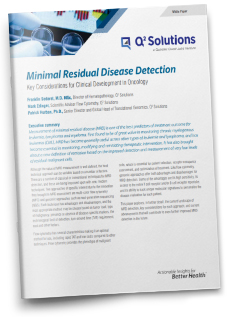
Minimal Residual Disease Detection: Key Considerations for Clinical Development in Oncology
Current MRD detection landscape, key considerations for each approach, and current advancements that will contribute to further improvements in MRD detection
Measurement of minimal residual disease (MRD) is one of the best predictors of treatment outcome for leukemia, lymphoma and myeloma.
Two approaches of specific interest due to the innovation they brought in MRD assessment are multi-color flow cytometry (MFC) and genomic approaches such as next-generation sequencing (NGS). Each technique has advantages and disadvantages, and the most appropriate method may be chosen based on tumor load, type of malignancy, presence or absence of disease-specific markers, the technological limit of detection, turn-around time (TAT) requirement, cost and other factors.
This paper explores, in further detail, the current landscape of MRD detection, key considerations for each approach, and current advancements that will contribute to even further improved MRD detection in the future.
Authors:
Franklin Sedarat, M.D. MSc, Director of Hematopathology, Scientific Advisor, Flow Cytometry
Patrick Hurban, Ph.D., Senior Director and Global Head, Translational Genomics
Complete the form below to access this white paper








